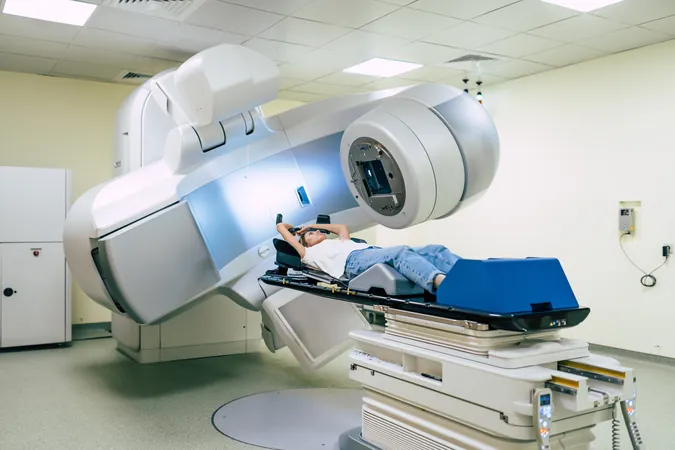
Game-Changer Alert: Updated Guidelines on Postmastectomy Radiation Therapy Released!
2025-09-18
Author: Ming
Revolutionizing Breast Cancer Treatment
In a groundbreaking update, three premier cancer organizations—the American Society of Clinical Oncology (ASCO), the American Society for Radiation Oncology (ASTRO), and the Society of Surgical Oncology (SSO)—have unveiled a new guideline focused on postmastectomy radiation therapy (PMRT) for breast cancer patients. This comprehensive set of recommendations is set to transform the way physicians treat breast cancer by integrating the latest evidence and innovative clinical practices.
Why PMRT Matters
Every year, over 100,000 individuals in the U.S. undergo mastectomy due to breast cancer. For patients deemed at high risk for recurrence—especially those with lymph node involvement—PMRT is crucial. By targeting areas where cancer could potentially return, PMRT not only annihilates lingering microscopic cells post-surgery but also significantly improves patients' chances for long-term survival.
Dr. Rachel B. Jimenez, a radiation oncologist at Massachusetts General Hospital and Co-Chair of the expert panel, emphasizes, "Radiation therapy post-mastectomy can drastically cut down the chances of cancer recurrence and enhance survival rates for many invasive breast cancer patients. However, the effectiveness of PMRT hinges on individual disease characteristics and personal choices, making evidence-based decision-making essential."
Updated Guidelines: What’s New?
These new guidelines reflect major advancements in diagnostics enabling doctors to pinpoint which patients stand to gain the most from PMRT following surgery. The updated recommendations also explore innovative treatment strategies that aim to minimize side effects and bolster effectiveness. These include breakthroughs in radiation techniques and personalized systemic therapies.
Dr. Kathleen C. Horst of Stanford University, who co-chaired the panel, notes, "This updated guideline clarifies a complex decision-making process, condensing the latest research into actionable insights for multidisciplinary treatment teams. The outcome? Tailored, safer, and more effective cancer treatment protocols."
Expert Insights on PMRT’s Role
Dr. Sarah E. Schellhorn from Yale School of Medicine adds, "PMRT is a vital element for most patients with node-positive breast cancer and select high-risk cases, according to the revised guidelines. These recommendations aim to provide clear guidance on target volumes, dosing, and treatment techniques, whether patients have received systemic treatment or not."
Dr. Cindy Matsen from the SSO highlights, "This guideline incorporates the most recent data, empowering us to customize patient care while acknowledging the gaps in our current understanding."
Key Takeaways from the Updated Guidelines
Here are some essential recommendations from the new guidelines:
1. Node-Positive Patients:
PMRT is highly recommended to mitigate recurrence and breast cancer mortality. In some cases, particularly with low recurrence risk, therapy omission could be considered based on individual patient and tumor characteristics.
2. Node-Negative Patients:
For those at heightened risk of local recurrence—like younger patients or those with larger tumors—PMRT is suggested. Generally, it’s not recommended for smaller pT1-2 tumors without lymph node involvement, unless multiple high-risk features are present.
3. Neoadjuvant Therapy Cases:
PMRT is recommended for patients diagnosed with locally advanced disease or who have residual nodal involvement after systemic therapy.
4. Treatment Protocols:
The guidelines provide comprehensive suggestions regarding treatment volumes and fractionation methods, favoring moderate hypofractionation but allowing for conventional fractionation in rare cases. Additionally, they address when a boost to the chest wall or axillary nodes could be beneficial.
5. Best Practices for Delivery:
Experts suggest using advanced planning technologies, including CT-based volumetric planning and techniques like intensity-modulated radiation therapy, to heighten precision and reduce side effects.
6. Collaborative Decisions:
Decisions about PMRT should involve a team of specialists and the patient to facilitate discussions about risks and benefits, ensuring the best treatment path is chosen.
Developed by a diverse expert panel of oncologists, physicists, and a patient representative, this updated guideline reflects a thorough review of research between 2005 and 2024. The initiative is backed by significant institutions like the American Society of Breast Surgeons and the Royal Australian and New Zealand College of Radiologists. With this update, healthcare providers are better equipped than ever to deliver personalized and effective care to breast cancer patients.


 Brasil (PT)
Brasil (PT)
 Canada (EN)
Canada (EN)
 Chile (ES)
Chile (ES)
 Česko (CS)
Česko (CS)
 대한민국 (KO)
대한민국 (KO)
 España (ES)
España (ES)
 France (FR)
France (FR)
 Hong Kong (EN)
Hong Kong (EN)
 Italia (IT)
Italia (IT)
 日本 (JA)
日本 (JA)
 Magyarország (HU)
Magyarország (HU)
 Norge (NO)
Norge (NO)
 Polska (PL)
Polska (PL)
 Schweiz (DE)
Schweiz (DE)
 Singapore (EN)
Singapore (EN)
 Sverige (SV)
Sverige (SV)
 Suomi (FI)
Suomi (FI)
 Türkiye (TR)
Türkiye (TR)
 الإمارات العربية المتحدة (AR)
الإمارات العربية المتحدة (AR)